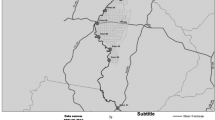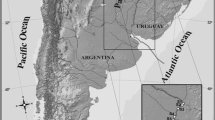Abstract
The evaluation of sediments, concerning to pesticides, constitutes an important step for the understanding of the principal sources of contamination of the surface water. Hence, the purpose of this study was to evaluate for the first time the occurrence, distribution and risk of pesticides in sediments of the Alqueva reservoir, the largest reservoir in the Europe. For this purpose, the occurrence of 22 pesticides and some of their degradation products was determined in surficial sediments of the Alqueva reservoir. To assess the potential risk on ecosystem, the measured concentrations of pesticides were compared with regulatory and toxicological benchmarks. Of the 22 pesticides analysed, only 8 were detected. Diuron was the pesticide detected in greater concentration, followed by terbuthylazine and chlortoluron. The sediments most polluted by pesticides were from Lucefécit, constituted totally by fine particles (<0.063 mm) and with high values of organic matter, and are located nearby large agricultural fields. The risk assessment allowed us to conclude that the sediments from the Alqueva reservoir presented low risk, concerning to pesticides, for the various communities that integrate the aquatic ecosystems. However, some of the compounds detected present a high potential for bioaccumulation that may lead to their bioamplification in the trophic chain, reaching concentrations higher than their acceptable daily intake, putting, in this way the populations at risk.



Similar content being viewed by others
References
CCME (Canadian Council of Ministers of the Environment) (2002) Canadian sediment quality guidelines for the protection of aquatic life, Canadian government
DGADR (Direcção Geral de Agricultura e Desenvolvimento Rural) (2011) Pesticidas a pesquisar em 2011, em água para consumo. Ministério da Agricultura do Desenvolvimento Rural e das Pesca (in Portuguese)
DHP-OCS (Department of Health Protection-Office of Chemical Safety) (2005) Acceptable daily intakes for agricultural and veterinary chemicals, Australian Government
EFSA (European Food Safety Authority) (2011) Peer review of the pesticide risk assessment of the active substance terbuthylazine. Eur Food Saf Authority J 9(1):1969
AERU (Agriculture and Environmental Research Unit) (2013) The PPDB pesticides properties database, University of Herfordshire. UK. http://sitem.herts.ac.uk/aeru/footprint/front_ppdb.htm
Feo ML, Ginebreda A, Eljarrat E, Barceló D (2010) Presence of pyrethroid pesticides in water and sediments of Ebro River Delta. J Hydrol 393:156–162
Gong XY, Qi SH, Wang YX, Julia EB (2007) Historical contamination and sources of organochlorine pesticides in sediments cores from Quanzhou Bay, Southeast China. Mar Pollut Bull 54(9):1434–1440
Goss D, Wauchope RD (1990) The SCR/ARS/CES pesticides properties database: II using with soils data in a screening procedure. In: Weigmann DL (ed) Pesticides in the next decade: the challenge ahead. Virginia Resources Research Centre, Blacksburg, pp 471–493
Gustafson DI (1989) Groundwater ubiquity score: a simple method for assessing pesticide leachability. Environ Toxicol Chem 8:339–357
Hermosin MC, Calderon MJ, Real M, Cornejo J (2013) Impact of herbicides used in olive groves on waters of the Guadalquivir river basin (southern Spain). Agric Ecosyst Environ 164:229–243
Köck-Schulmeyer M, Olmos M, López de Alda M, Barceló D (2013) Development of a multiresidue method for analysis of pesticides in sediments based on isotope dilution and liquid chromatography-electrospray-tandem mass spectrometry. J Chromatogr A 1305:176–187
Li Y, Niu J, Shen Z, Zhang C, Wang Z, He T (2014) Spatial and seasonal distribution of organochlorine pesticides in the sediments of the Yangtze Estuary. Chemosphere 114:233–240
Másia A, Campo J, Vázquez-Roig P, Blasco C, Picó Y (2013) Screening of currently used pesticides in water, sediments and biota of the Guadalquivir River Basin (Spain). J Hazard Mater 263P:95–104
Morais MM, Serafim AM, Pinto P, Ilhéu A, Ruivo M (2007) Monitoring the water quality in Alqueva Reservoir. Guadiana River southern Portugal, In: Gunter G. Carmo M. (Eds), Reservoir and river basin management: exchange of experiences from Brazil. Portugal and Germany. Berlim, pp 96-112
Myers N, Mittermeier RA, Mittermeier CG, Fonseca GAB, Kent J (2000) Biodiversity hotspots for conservation priorities. Nature 403:853–858
Nemr AE, Moneer AA, Khaled A, El-Sikaily A (2012) Contamination and risk assessment of organochlorines in surface sediments of Egyptian Mediterranean coast. Egypt J Aquat Res 38:7–21
Palma P, Kuster M, Alvarenga P, Palma VL, Fernandes RM, Soares AMVM, López de Alda MJ, Barceló D, Barbosa IR (2009) Risk assessment of representative and priority pesticides in surface water of the Alqueva reservoir (South of Portugal) using on-line solid phase extraction-liquid chromatography-tandem mass spectrometry. Environ Int 35:545–551
Palma P, Alvarenga P, Palma V, Fernandes RM, Soares AMVM, Barbosa IR (2010a) Assessment of anthropogenic sources of water pollution using multivariate statistical techniques: a case study of the Alqueva’s reservoir. Portugal. Environ Monit Assess 165:539–552
Palma P, Alvarenga P, Palma V, Matos C, Fernandes RM, Soares AMVM, Barbosa IR (2010b) Evaluation of surface water quality using an ecotoxicological approach: a case study of the Alqueva Reservoir (Portugal). Environ Sci Pollut R 17:703–71
Palma P, Ledo L, Soares S, Barbosa IR, Alvarenga P (2014a) Spatial and temporal variability of the water and sediments quality in the Alqueva reservoir (Guadiana Basin; Southern Portugal). Sci Total Environ 470–471: 780–790
Palma P, Köck-Schulmeyer M, Alvarenga P, Ledo L, Barbosa IR, López de Alda M, Barceló D (2014b) Risk assessment of pesticides detected in surface water of the Alqueva reservoir (Guadiana basin, southern of Portugal). Sci Total Environ 488–489: 208–219
Rodrigues ET, Lopes I, Pardal MA (2013) Occurrence, fate and effects of azoxystrobin in aquatic ecosystems: a review. Environ Int 53:18–28
Toan PV, Sebesvari Z, Bläsing M, Rosendahl I, Renaud FG (2013) Pesticide management and their residues in sediments and surface and drinking water in the Mekong Delta, Vietnam. Sci Total Environ 452–453: 28–39
Villarde J, Hildebrandt A, Martínez E, Lacorte S, Morillo E, Maqueda C, Viana P, Barceló D (2008) Priority pesticides and their degradation products in river sediments from Portugal. Sci Total Environ 390:507–513
Wang L, Jia H, Liu X, Sun Y, Yang M, Hong W, Qi H, Li Y (2013) Historical contamination and ecological risk of organochlorine pesticides in sediment core in northeastern Chinese river. Ecotoxicol Environ Saf 93:112–120
Wu C, Zhang A, Liu W (2013) Risks from sediments contaminated with organochlorine pesticides in Hangzhou, China. Chemosphere 90:2341–2346
Yuan L, Qi S, Wu X, Wu C, Xing X, Gong X (2013) Spatial and temporal variations of organochlorine pesticides (OCPS) in water and sediments from Honghu Lake, China. J Geochem Explor 132:181–187
Zhou S, Yang H, Zhang A, Li Y, Liu W (2014) Distribution of organochlorine pesticides in sediments from Yangtze River Estuary and the adjacent East China Sea: implication of transport, sources and trends. Chemosphere 114:26–34
Acknowledgments
The present research has been financially supported by the project PTDC/AAC-AMB/103547/2008 from the FCT (Fundação para a Ciência e Tecnologia), by FEDER through the POFC (Eixo I - Programa Operacional Fatores de Competitividade) from the QREN (COMPETE Refª: FCOMP-01-0124-FEDER-008582). Logistic support for sampling was provided by the Portuguese Environmental Agency (APA—Agência Portuguesa do Ambiente).
Author information
Authors and Affiliations
Corresponding author
Additional information
Responsible editor: Hongwen Sun
Rights and permissions
About this article
Cite this article
Palma, P., Köck-Schulmeyer, M., Alvarenga, P. et al. Occurrence and potential risk of currently used pesticides in sediments of the Alqueva reservoir (Guadiana Basin). Environ Sci Pollut Res 22, 7665–7675 (2015). https://doi.org/10.1007/s11356-015-4390-1
Received:
Accepted:
Published:
Issue Date:
DOI: https://doi.org/10.1007/s11356-015-4390-1




